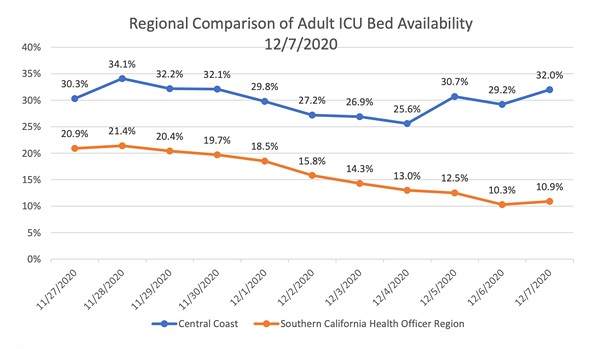[{
"name": "Ad - Medium Rectangle CC01 - 300x250",
"id": "AdMediumRectangleCC01300x250",
"class": "inlineCenter",
"insertPoint": "8",
"component": "2963441",
"requiredCountToDisplay": "12"
},{
"name": "Ad - Medium Rectangle LC01 - 300x250",
"id": "AdMediumRectangleCC01300x250",
"class": "inlineCenter",
"insertPoint": "18",
"component": "2963441",
"requiredCountToDisplay": "22"
},{
"name": "Ad - Medium Rectangle LC09 - 300x250",
"id": "AdMediumRectangleLC09300x250",
"class": "inlineCenter",
"insertPoint": "28",
"component": "3252660",
"requiredCountToDisplay": "32"
}]
San Luis Obispo, Santa Barbara, and Ventura counties are banding together in hopes of creating a Central Coast region on the state's new stay-at-home order map.
At a press conference on Dec. 3, Gov. Gavin Newsom announced another system for tracking and slowing California's currently exploding cases of COVID-19, a process that splits the state up into five regions where stay-at-home orders are triggered when the area's intensive care unit (ICU) availability drops to or below 15 percent. When leaders in SLO and Santa Barbara counties discovered that the Central Coast would be lumped into the Southern California region, the pushback was almost immediate.
In a Dec. 7 letter addressed to acting State Health Officer Erica Pan, public health officers and directors in SLO, Santa Barbara, and Ventura counties wrote that while they agree with using a hospital-based metric to trigger safety regulations, "the utilization of such a large and diverse regional assignment is not reflective of the risks for our Central Coast area."
"Unlike the rest of the Southern California regional boundaries being utilized for COVID-19 mitigation," the letter reads, "we strongly anticipate that the three weeks in [a regional stay-at-home order] will allow us to rapidly reset our case rates and testing positivity, and further improve our ICU capacity."
SLO County's hospitals in particular are less busy with COVID-19 cases than those in other parts of California. While Los Angeles County is grappling with a per capita hospitalization rate of 32.6 per 100,000 residents, SLO County's sits at 4.23 per 100,000, one of the lowest hospitalization rates in the state, according to a CalMatters tracker. As of Dec. 9, only three of SLO County's 53 ICU beds were being used to treat COVID-19 patients, according to the county dashboard.
At a SLO County Board of Supervisors meeting on Dec. 8, Public Health Officer Dr. Penny Borenstein said she hopes the state will seriously consider allowing the Central Coast to move forward as a separate entity.
"Allowing this change would not have any significant impact to the rest of the [Southern California] region, as we are relatively small compared to the rest of the region," Borenstein said at the meeting. "And we would be able to continue to monitor what's going on in our county and work collaboratively and cooperatively with the state, but in a way that makes more sense for our county, as we not only have a high proportion of our beds available, we also, as you know, have an alternate care site that is available, and we think that we're in much better shape than other parts of the state and especially the Southern California region."
Scores of community members called in to SLO County's Dec. 8 meeting and a Santa Barbara County Board of Supervisors meeting on the same day, asking supervisors to send additional letters to the state in support of a Central Coast region.
Although both the SLO and Santa Barbara county supervisors voted unanimously to do so, California Health and Human Services Secretary Mark Ghaly said at a press conference on Dec. 8 that such a split is unlikely. He said the five regions were chosen based on maps state health officers have used in the past to respond to other public health issues.
While not all counties in each region are experiencing the same surge, Ghaly said each offer a "thoughtful collection" of resources in the hospital delivery system, ensuring that if one part of a region were to have a sudden increase in hospitalizations, patients from that area could be moved to other places where additional resources exist.
"I've certainly been part of conversations asking questions about it," Ghaly said, "and at the moment we don't have an intention to make a change to the regions." Δ
Latest in News
Readers also liked…
-

Coast Unified teachers upset over new position's salary and qualifications
Oct 20, 2022 -

SLO police identify alleged driver who hit and killed couple
Dec 22, 2022 -

When the levee breaks: Oceano residents, county officials walk a tightrope of regulations to manage Arroyo Grande Creek, which some say led to the levee's failure in January
May 18, 2023










